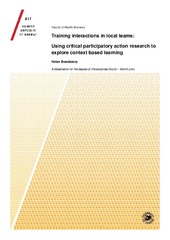Training interactions in local teams: Using critical participatory action research to explore context based learning
Permanent link
https://hdl.handle.net/10037/10149View/
Thesis introduction (PDF)
Paper 3: Brandstorp, H., Halvorsen, P. A., Sterud, B., Haugland, B., Kirkengen, A. L.: ”Primary care emergency team training in situ means learning in real context”. Also available in Scandinavian Journal of Primary Health Care 2016. (PDF)
Date
2017-01-09Type
Doctoral thesisDoktorgradsavhandling
Author
Brandstorp, HelenAbstract
Akuttmedisinske pasienter har ofte krevende og komplekse medisinske behov som lokale, tverrfaglige team må bidra til å møte. Akuttmedisinforskriften pålegger trening i samhandling for tjenestene utenfor sykehus. Vi ønsket derfor å utforske og forbedre lokal team trening.
I Alta har lokalt helsepersonell systematisk arrangert slike treninger hver måned siden 2007, forankret i egen kompetanse og egen kontekst. Vår studie har utforsket pasientdeltagelse, lederskap som samhandling og lokal læring gjennom 3,5 år. Vi var deltagende observatør i ett år, analyserte funn i en tverrfaglig forskergruppe og arrangerte så lokale fokusgrupper om hvert tema.
Analysene avslørte et dominerende språkbruk som objektiverte både de simulerte pasientene og de lokale deltagerne. Teamene hadde både utpekte ledere og praktiserte delt lederskap. Lederskapet endret seg gjerne i det situasjonen krevde en spesiell kompetanse. I tillegg var følgende prinsipper styrende: dedikasjon til oppgaven man stod i, å ta ansvar for pasient og kolleger, en oppfatning av at ro var en indikator for godt teamarbeid.
Deltagerne diskuterte en rekke forhold om tilsammen inngår i læring og i bygging av pasientsikkerhetskultur, og de gjorde både sosiale og strukturelle endringer i løpet av studien.
Den fleksible strukturen til treningsmodellen speiler kompleksiteten i medisinen og gir rom for deltagernes egen ansvarlighet.
Lokalt tilpasset team trening i tråd med slik de gjør det i Alta bør kunne inspirere andre kommuner. During emergencies, patients often have challenging and complex needs that local, interprofessional health care teams must address. Norwegian regulations mandate training in emergency primary care. We aimed thus to explore and improve in situ team training.
In Alta, local personnel has continually since 2007 arranged such trainings once a month, anchored in their own competence and context. During 3.5 years, we explored patient participation, leadership as interaction, and local learning processes. We conducted one year of participatory observation, analyses by an interprofessional group and then local, follow-up focus group discussions on each theme.
Analyses revealed a dominance of language that objectified the simulated patients and participating professionals. The teams practiced both designated and distributed leadership with shifts in leadership modes coinciding with situational changes requiring specific competencies. Additional guiding principles included: a commitment to the task at hand; taking responsibility for patients and colleagues; and, a perception of calmness as an indicator of good teamwork.
The participants discussed a wide range of topics constitutive for learning and for a patient safety culture and made social and structural improvements. The flexible structure of the training model mirrors the complexity of medicine and provides space for the participants' own sense of responsibility.
Description
The papers 1 and 2 of this thesis are not available in Munin.
Paper 1: Brandstorp, H., Kirkengen, A. L., Halvorsen, P. A., Sterud, B., Haugland, B.: “Training interaction in primary care emergency teams: the role of the patient”. Available in The International Journal of Person Centered Medicine 2012, 2(4):656-663.
Paper 2: Brandstorp, H., Kirkengen, A. L., Sterud, B., Haugland, B., Halvorsen, P. A.: “Leadership practice as interaction in primary care emergency team training”. Available in Action Research 2015, 13(1):84-101.
Paper 1: Brandstorp, H., Kirkengen, A. L., Halvorsen, P. A., Sterud, B., Haugland, B.: “Training interaction in primary care emergency teams: the role of the patient”. Available in The International Journal of Person Centered Medicine 2012, 2(4):656-663.
Paper 2: Brandstorp, H., Kirkengen, A. L., Sterud, B., Haugland, B., Halvorsen, P. A.: “Leadership practice as interaction in primary care emergency team training”. Available in Action Research 2015, 13(1):84-101.
Publisher
UiT The Arctic University of NorwayUiT Norges arktiske universitet
Series
ISM skriftserie; 175Metadata
Show full item recordCollections
- Doktorgradsavhandlinger (Helsefak) [770]
- ISM skriftserie [161]
Copyright 2017 The Author(s)
The following license file are associated with this item:


 English
English norsk
norsk
